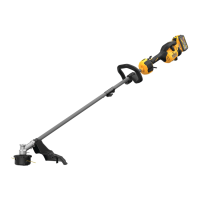does not apply to the vehicular charger.
Foreign materials of a conductive nature, such as, but not limited to, grinding dust, metal chips, steel wool, aluminum foil or any
buildup of metallic particles should be kept away from the charger cavities and ventilation slots.
Always unplug the charger from the power supply when there is no battery pack in the cavity.
Charging a Battery (Fig. C)
1. Plug the charger into an appropriate outlet.
2. Insert and fully seat battery pack. The red charging light will continuously blink while charging.
3. Charging is complete when the red charging light remains continuously ON. Battery pack can be left in charger or removed. Some chargers
require the battery pack release button to be pressed for removal.
WARNING: Only charge batteries in air temperature over 40° F (4.5° C) and below 105° F (+40.5° C).
4. Charger will not charge a faulty battery pack, which may be indicated by the light staying OFF. Take charger and battery pack to an authorized
service center if light stays OFF.
NOTE: Refer to label near charging light on charger for blink patterns. Older chargers may have additional information and/or may not have a
yellow indicator light.
Hot/Cold Pack Delay
When the charger detects a battery pack that is too hot or too cold, it automatically starts a Hot/Cold Pack Delay, suspending charging until the battery
pack has reached an appropriate temperature. The charger then automatically switches to the pack charging mode. This feature ensures maximum
battery pack life.
A cold battery pack may charge at a slower rate than a warm battery pack.
The hot/cold pack delay will be indicated by the red light continuing to blink but with the yellow light continuously ON. Once the battery pack has
reached an appropriate temperature, the yellow light will turn OFF and the charger will resume the charging procedure.
DCB118 and DCB1112 Chargers
The DCB118 and DCB1112 chargers are equipped with an internal fan designed to cool the battery pack. The fan will turn on automatically when the
battery pack needs to be cooled.
Electronic Protection System
Li-Ion tools are designed with an Electronic Protection System that will protect the battery pack against overloading, overheating, or deep discharge.
The tool will automatically turn off and the battery pack will need to be recharged.
Important Charging Notes
1. The charger and battery pack may become warm to the touch while charging. This is a normal condition and does not indicate a problem. To
facilitate the cooling of the battery pack after use, avoid placing the charger or battery pack in a warm environment such as in a metal shed or an
uninsulated trailer.
2. If the battery pack does not charge properly:
a. Check operation of the receptacle by plugging in a lamp or other appliance;
b. Check to see if the receptacle is connected to a light switch that turns the power off when you turn out the lights;
c. If charging problems persist, take the tool, battery pack, and charger to your local service center.
3. You may charge a partially used pack whenever you desire with no adverse effect on the battery pack.
Charger Cleaning Instructions
WARNING: Shock hazard. Disconnect the charger from the AC outlet before cleaning. Dirt and grease may be removed from the exterior of the
charger using a cloth or soft non‑metallic brush. Do not use water or any cleaning solutions.
Wall Mounting
Some DeWALT chargers are designed to be wall mountable or to sit upright on a table or work surface. If wall mounting, locate the charger within
reach of an electrical outlet, and away from a corner or other obstructions which may impede airflow. Use the back of the charger as a template for the
location of the mounting screws on the wall. Mount the charger securely using drywall screws (purchased separately) at least 1” (25.4 mm) long, with
a screw head diameter of 0.28–0.35” (7–9 mm), screwed into wood to an optimal depth leaving approximately 7/32” (5.5 mm) of the screw exposed.
Align the slots on the back of the charger with the exposed screws and fully engage them in the slots.
SAVE THESE INSTRUCTIONS FOR FUTURE USE ASSEMBLY AND ADJUSTMENTS
WARNING: To reduce the risk of serious personal injury, turn unit off and remove the battery pack before making any adjustments or removing/
installing attachments or accessories. An accidental start‑up can cause injury.
Attaching the Auxiliary Handle (Fig. A, C)
1. Place the auxiliary handle 6 on top of the handle base 17 so the upper powerhead pole 19 is between them.
2. Hold the auxiliary handle in place and slide the handle bolts 18 and washers into the handle from the top, threading them into the handle base.
3. Tighten the handle bolts with the supplied hex wrench. Ensure the handle is securely attached.
4. Repeat for the other side of the auxiliary handle.
Powerhead (Fig. B)
WARNING: To reduce risk of injury:
Before any use, be sure everyone using this product reads and understands all safety instructions and other information contained in the
powerhead
and attachment manuals.
Never apply power without an attachment being properly mounted to the powerhead.

